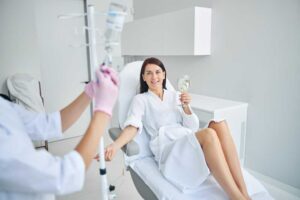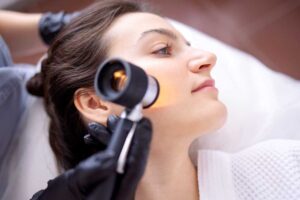Lip fillers have become an incredibly popular cosmetic procedure, offering a quick way to improve the volume and shape of your lips. However, like any injectable treatment, lip filler injections can come with temporary side effects, most notably swelling and bruising. If you’re thinking about going for lip filler treatment, understanding how long bruising lasts after lip fillers is necessary for managing your expectations and ensuring a smooth recovery.
The Science Behind Lip Filler Bruising
Lip filler bruising happens when the tiny needles used during the lip filler procedure rupture small blood vessels beneath the surface of your skin. This causes blood to leak into the surrounding tissues, resulting in discoloration. The degree of bruising after lip fillers depends on individual sensitivity, the technique used by the provider, and the type of dermal fillers injected, usually “hyaluronic acid.”
Factors Influencing Bruising Severity
There are multiple factors that can influence the duration and severity of lip filler bruising. Let’s explore these factors one by one.
Sensitivity Level of Each Person
Some people are naturally more prone to bruising than others. This can be due to pre-existing medical conditions, thinner skin, or genetic predispositions.
Medications
Certain medications, especially blood-thinning medications like warfarin, aspirin, and ibuprofen, can exacerbate bruising by interfering with blood clotting. Even some herbal supplements can have this effect.
Alcohol Consumption
Avoid alcohol for at least 24 hours before and after your lip filler injections, as it can dilate your blood vessels, which can increase the risk of bruising.
Technique and Injection Sites
The skill of the provider and the specific injection sites also play a role. Areas like your upper lip tend to be more vascular, making them more susceptible to bruising.
Strenuous Exercise
Strenuous exercise increases blood flow, worsening bruising and delaying healing.
The Timeline: How Long Does Bruising Last After Lip Fillers?
While the exact duration of bruising after lip fillers varies, here’s a general timeline that you should know if you are thinking about lip fillers.
The first 24 to 48 Hours
This is when bruising is generally at its worst! You may notice discoloration, ranging from blue or black to red or purple. Lip filler swelling is also most pronounced during this time.
3 to 5 Days
The bruising will fade, transitioning to a yellowish or greenish hue as the body breaks down the leaked blood. Lip filler swelling stages will also start to decrease.
7 to 10 Days
Most bruising should have subsided by this point; however, some residual discoloration may have persisted.
In rare cases, minor bruising may linger for up to two weeks. However, if you experience prolonged or severe bruising, you should immediately consult with your cosmetic physician.
Managing Bruising & Swelling
Bruising is unavoidable. However, several steps can be taken to reduce bruising and swelling after your lip filler procedure. Let’s discuss them one by one!
For the first 36 to 48 hours, apply cold compresses to the treated area for 10 to 15 minutes at a time, several times a day. This helps to constrict your blood vessels and minimize swelling and bruising.
Topical or oral arnica, a natural remedy, can help reduce bruising and inflammation.
When sleeping or resting, elevate your head with extra pillows. This will minimize swelling.
As mentioned earlier, avoid blood-thinning medications and alcohol for a few days before and after the lip filler treatment.
While strenuous exercise should be avoided, gentle movement can help promote blood circulation and aid healing.
Strictly follow the aftercare instructions given by your doctor or the provider who performed the procedure. This could be an aesthetic physician, dermatologist, or cosmetic physician. Follow their instructions strictly to get the best results.
Addressing Swelling Due to Lip Fillers
Lip filler swelling is a common and normal reaction to filler injections. It generally subsides within a few days. The peak of the lip filler swelling is usually within the first 48 hours. During this time, you should:
- Staying well-hydrated can help minimize swelling
- Avoid salty foods, which can retain water and worsen swelling
- Apply gentle pressure to the lips with a clean cloth can help to reduce swelling
Lip Fillers Hurt?: Managing Discomfort
While lip fillers hurting is a common concern! Most of you experience only mild discomfort during the procedure. Numbing cream is generally applied to the lips before the injections to minimize pain. After the procedure is done, some soreness and tenderness are normal.
When to Seek Medical Attention
While mild swelling and bruising are expected, you should be aware of potential complications.
Get immediate medical attention if you experience:
- Severe pain or swelling
- Signs of infection, such as pus, redness, etc
- Changes in color or texture of your skin beyond normal bruising
- Difficulty breathing or swallowing
The Bottom Line
Understanding how long does bruising last after lip fillers is highly important for setting realistic expectations. While bruising is a common side effect, it’s generally temporary and manageable. Following proper lip filler aftercare tips and working with a qualified aesthetic physician or dermatologist can minimize bruising and get the shape of the lips you always wanted. Remember that the healing process is unique for everyone. So, be patient and get in touch with your doctor if you feel any complications.
Call the Skin Artistry Clinic for Fillers & More
The Skin Artistry Clinic provides advanced aesthetic and wellness treatments, including longevity medicine, wellness treatments, dermal fillers, RF microneedling, Hydrafacial, and IV therapy, ensuring a professional approach. We proudly serve clients in Danville, Orinda, Piedmont, Pleasant Hill, Clayton, Concord, and surrounding areas.
We are also offering Botox®/Dysport®, SkinVive™ by Juvéderm®, IPL skin rejuvenation (“Photofacial”), Kybella, microneedling with PRP (“Vampire Facial“), and more. Call us today to schedule your appointment with our expert aesthetic physicians!



